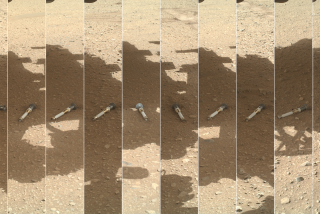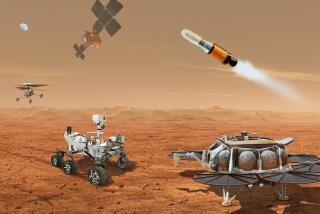Damaged Panel Delays Project to Map Mars
A damaged solar panel on the $250-million Global Surveyor spacecraft now orbiting Mars has forced NASA officials to delay the start of the probe’s key mapping mission by at least a year and added several million dollars to its cost.
National Aeronautics and Space Administration officials at the Jet Propulsion Laboratory said Monday they redesigned the mission to avoid further damage to a fragile, 11-foot-long solar panel that threatened to snap off as the craft dipped repeatedly into the planet’s unexpectedly dense atmosphere. The latch that holds the solar panel in place apparently was damaged during the probe’s launch last November, and NASA already has revamped the mission once to avoid any further stress on the loose panel.
After suspending the probe’s maneuvers for almost a month to analyze the problem, JPL mission officials in Pasadena and flight engineers at Lockheed Martin Astronautics in Denver gingerly resumed a braking operation--called aerobraking--that will gradually tighten the spacecraft’s orbit around Mars in preparation to map the planet.
Mapping is now expected to begin in March 1999--a year later than originally planned. The Surveyor probe was meant to map the planet for 24 months--a complete Martian year--but now the spacecraft could have as little as nine months devoted to its mapping mission, JPL officials said.
NASA officials said Monday they do not yet know exactly how much of the mapping mission they will complete, how much the additional year of mission operations will cost, or if they will be able to find the money in the limited planetary exploration budget to pay for it.
“We designed a completely new mission in four weeks,” Glenn E. Cunningham, the Mars Surveyor Operations project manager, said Monday.
“Clearly, operating for another year in Mars orbit will probably cost several million dollars. We have not worked out all the details yet on what levels of work force we will provide to fly the spacecraft . . . or exactly how much effort the science teams will need to put in,” he said. “We are in the process of determining that exact number over the next couple of months.”
Mission scientists, however, have taken advantage of the recent delay to reap an unexpected bonanza of images of the planet’s plains, volcanoes and valleys as well as the first nighttime views of Martian clouds. And they expect the extra time in orbit will offer other opportunities for scientific study of the mysterious Red Planet.
“We will not get the total number of [mapping] photographs we had originally planned,” said project scientist Arden L. Albee at Caltech. “We will not get the number of scans over the entire planet, but we will get the global coverage of the mission. We will be able to keep track of the atmosphere over the full Martian year, but we will not track it in quite the detail we had originally planned.”
In the end, the altered mission plan may not seriously affect the quality of the Surveyor’s scientific results, JPL officials said.
On Monday, JPL officials released the results of science studies conducted during the month the mission was effectively in a holding pattern around Mars.
New high-resolution panoramas of the planet revealed an evocative landscape washed in waves of dust drifting like new snow. The Surveyor camera caught images of seas of active sand dunes, ancient landslides, patches of sunken, cracked terrain in the Schiaparelli Crater that resemble dry lake beds, and layer-cake cliffs 4,000 feet high in the Valles Marineris.
“If you did not know this was Mars, you might say it was part of the Rocky Mountains or the Himalayas,” said Michael Malin, from Malin Space Science Systems in San Diego, the principle investigator in charge of Surveyor’s on-board camera.
Altimeter readings from Surveyor reveal vast expanses of the Great Plains of Mars--relatively featureless and stable terrain that encompasses large regions of the planet’s surface. A detailed laser altimeter study of the Martian volcano Arsia Mons, itself 10 miles high, profiled a volcanic crater almost 63 miles across and 3,000 feet deep.
“Not only is it more than 60 miles across, but you could put the whole L.A. Basin inside the caldera,” said David Smith, who is in charge of the laser altimeter at NASA’s Goddard Space Flight Center.






